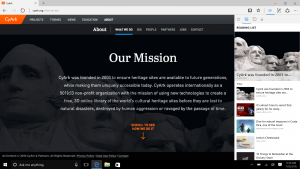 Windows 10 has been out in the wild for about three months now. A frequent question we get here at OIT is “How is it?” and “Should I upgrade?” In the IT industry, we always like to thoroughly test things out before putting our approval stamp on it. After a few months with Windows 10, we can now make some recommendations.
Windows 10 has been out in the wild for about three months now. A frequent question we get here at OIT is “How is it?” and “Should I upgrade?” In the IT industry, we always like to thoroughly test things out before putting our approval stamp on it. After a few months with Windows 10, we can now make some recommendations.

As many people know either by personal experience or word of mouth, Windows 8.1, the previous version of Windows, was a very divisive iteration. The Start button evolved into the Start Screen, a strange mix of menus and giant colorful buttons that left a bad taste in the mouths of many. Windows 10 has backed off of the Start Screen and tile concept, bringing back the good ‘ol Start button and start menu, albeit with some changes.
One feature that has carried on from Windows 8.1 is the recommendation that a Microsoft Account be used to log into your computer. This allows the majority of your computer settings, from font sizes to wallpaper, to be synced to all of your computers and devices that also use your Microsoft Account. Your settings will even carry over to a friend’s computer if you use this account. If this type of feature isn’t your cup of tea, you can always create a regular local account like you could in Windows 7 and versions previous.

A very noticeable change from previous versions of Windows is the web browser. Gone is the ubiquitous Internet Explorer that has graced Windows since 1995. The replacement is Microsoft Edge and has a familiar looking blue E for its logo. Although the logo may be similar, the two browsers couldn’t be more different. Edge is a very lean, stripped-down browser. It’s fast and simple to use but has significant drawbacks in that it has very little customization features and does not currently allow add-ons like IE. Microsoft intends to add back the add-on capability next year. In the meantime, we recommend using a different browser like Firefox or Google Chrome if you need a little bit more flexibility.
Other cool features include better multiple display support, Cortana; a voice-activated search tool and “personal assistant,” as well as improved built-in programs for e-mail, paint, etc.
Another huge factor in recommending Windows 10 is its reliability. So far, we haven’t found many major issues regarding program compatibility or glaring bugs that would negatively affect the user experience. Issues that you may run into could include hardware driver compatibility problems if the manufacturer has not provided a Windows 10 compatible update for your particular device. Apart from this, there have been few issues that would be considered severe.
Overall, Windows 10 has proven to be a solid and enjoyable experience in its first few months of life. If your machine meets the minimum requirements, you can upgrade without much worry. If you use Windows 8 or 8.1, we definitely recommend the upgrade in order to revive much-needed usability.


